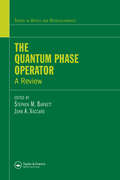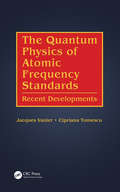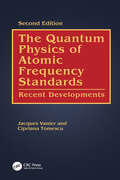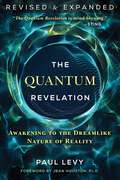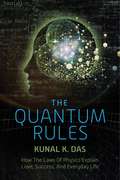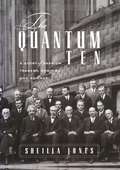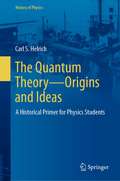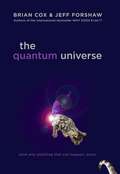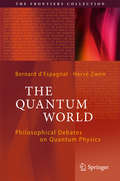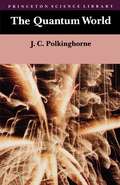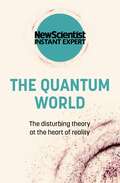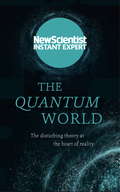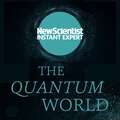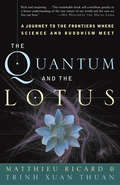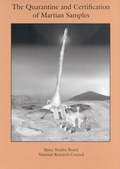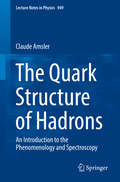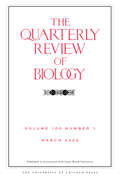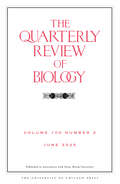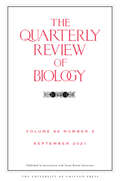- Table View
- List View
The Quantum Phase Operator: A Review
by Stephen M. Barnett John A. VaccaroDescribing the phase of an electromagnetic field mode or harmonic oscillator has been an obstacle since the early days of modern quantum theory. The quantum phase operator was even more problematic with the invention of the maser and laser in the 1950s and 1960s. This problem was not solved until the Pegg-Barnett formalism was developed in the 1980
The Quantum Physics of Atomic Frequency Standards: Recent Developments
by Jacques Vanier Cipriana TomescuUp-to-Date Coverage of Stable and Accurate Frequency StandardsThe Quantum Physics of Atomic Frequency Standards: Recent Developments covers advances in atomic frequency standards (atomic clocks) from the last several decades. It explains the use of various techniques, such as laser optical pumping, coherent population trapping, laser cooling, and e
The Quantum Physics of Atomic Frequency Standards: Recent Developments
by Jacques Vanier Cipriana TomescuThe Quantum Physics of Atomic Frequency Standards: Recent Developments, Second Edition, covers advances in atomic frequency standards (atomic clocks) from the last several decades. It explains the use of various techniques, such as laser optical pumping, coherent population trapping, laser cooling, and electromagnetic and optical trapping, in the implementation of classical microwave and optical atomic frequency standards.It provides an up-to-date, in-depth view of the vast improvements to atomic clocks that have occurred in the last 25 years. The improved stability and accuracy enable the verification of physical concepts used in fundamental theories, such as relativity, as well as the stability of fundamental constants intrinsic to those theories.The book first discusses improvements to conventional atomic frequency standards, highlighting the main limitations of those frequency standards and the physical basis of the limitations. It then describes how advances in the theory and applications of atomic physics have opened new avenues in frequency standards. The authors go on to explore the research and development of new microwave and optical frequency standards before presenting the results in frequency stability and accuracy achieved with these new frequency standards. They also illustrate the application of atomic clocks in metrology, telecommunications, navigation, and other areas and give some insight into future work.This new edition examines updated developments on the frequency standards, alongside content on the International System of Units (SI) and the role of atomic clocks on their base units. It also features new material on Coherent Population Trapping and new developments in the field of optical frequency standards.Key Features: Describes the basic physics, including quantum mechanics, behind the operation of atomic clocks. Explores new frequency standards that provide better stability and accuracy than older, more conventional standards. Discusses the importance of the field in the general context of physics. Jacques Vanier is retired from the National Research Council of Canada and as adjunct professor in the Physics Department at the University of Montreal. He is a fellow of the Royal Society of Canada, the American Physical Society, and the Institute of Electrical and Electronic Engineers. He has written more than 120 journal articles and proceedings papers and is the author of several books on masers, lasers, and atomic clocks. His main research work is oriented toward the understanding and application of quantum electronics phenomena.Cipriana Tomescu is retired from The Institute of Physics, Bucharest, Romania, and as invited researcher in the Physics Department at the University of Montreal. She is the author of numerous articles in scientific journals and conference proceedings. Her research involves state-of-the-art atomic frequency standards and H masers.
The Quantum Revelation: Awakening to the Dreamlike Nature of Reality
by Paul Levy• Shows how the revelations emerging from quantum physics can wake us up from the disempowering spell of the scientific materialist worldview and help dispel the collective madness that has befallen our species• Explains for readers with no physics background why quantum physics is, in the words of Albert Einstein, so &“uncommonly important&” that &“it should be everyone&’s concern&”• Shows how quantum physics can help us awaken to the malleable, dreamlike nature of reality, a realization that unlocks the creative spirit within usExplaining the world-transforming effects of quantum physics, Paul Levy shows how discoveries in this field—widely considered the greatest in the history of science—can wake us up from the disempowering spell of the reductionist, materialist worldview, thereby helping to dispel the collective madness that has befallen our species. He explains how quantum physics helps us to consciously realize our vast evolutionary potential and awaken us to the malleable, dreamlike nature of reality, a realization that unlocks the creative spirit hidden within our own minds. In a radical synthesis of quantum physics with spirituality, psychology, lucid dreaming, and alchemy, Levy contemplates the deeper philosophical and metaphysical underpinnings of quantum mechanics, exploring what it means that quantum physics has empirically proven that there is no such thing as &“objective reality&” and how we are active participants in creating our experience of reality, whether we realize it or not.Revealing the quantum nature of our world and ourselves, The Quantum Revelation shows how quantum physics has become a modern-day spiritual path for awakening and expanding consciousness with particular relevance for the challenging times we are living through.
The Quantum Rules: How the Laws of Physics Explain Love, Success, and Everyday Life
by Kunal K. DasA New York Times Best Seller!Here is a book to lead you through the fascinating intersections of life and physics with humor and intelligence.Find out how the laws of physics define every aspect of our lives and society, from human nature and relationships to geopolitical issues like financial markets, globalization and immigration. The Quantum Rules is a different kind of physics book, as easy to read as a novel and directly relevant for everyday life issues that affect us all. It is not meant to dazzle you with unproven speculations that have no bearing on your life. Rather, The Quantum Rules will familiarize you with the important and established laws at the heart of physics, in a way never done before - by showing how the defining patterns of our lives, our behavior and our society already follow similar rules.Never took an interest in science before? No problem! you will still understand everything and find plenty to relate to. A scientist or a science junkie? You will find a different perspective on things you may already know. Best of all, you will discover how to have meaningful conversations about physics in a way that won’t make eyes glaze over, and in which all can gladly participate.The Quantum Rules also does something you would never expect from a book on physics - it makes you laugh, often. Its new and original take on established natural laws injects plenty of dry humor into this serious subject, by using life to explain physics and in turn using physics to understand life.
The Quantum Ten: A Story of Passion, Tragedy, Ambition and Science
by Sheilla JonesTheoretical physics is in trouble. At least that’s the impression you’d get from reading a spate of recent books on the continued failure to resolve the 80-year-old problem of unifying the classical and quantum worlds. The seeds of this problem were sewn eighty years ago when a dramatic revolution in physics reached a climax at the 1927 Solvay conference in Brussels. It’s the story of a rush to formalize quantum physics, the work of just a handful of men fired by ambition, philosophical conflicts and personal agendas. Sheilla Jones paints an intimate portrait of the ten key figures who wrestled with the mysteries of the new science of the quantum, along with a powerful supporting cast of famous (and not so famous) colleagues. The Brussels conference was the first time so many of the “quantum ten” had been in the same place: Albert Einstein, the lone wolf; Niels Bohr, the obsessive but gentlemanly father figure; Max Born, the anxious hypochondriac; Werner Heisenberg, the intensely ambitious one; Wolfgang Pauli, the sharp-tongued critic with a dark side; Paul Dirac, the silent Englishman; Erwin Schrödinger, the enthusiastic womanizer; Prince Louis de Broglie, the French aristocrat; Pascual Jordan, the ardent Aryan nationalist, who was not invited; and Paul Ehrenfest, who was witness to it all. This is the story of quantum physics that has never been told, an equation-free investigation into the turbulent development of the new science and its very fallible creators, including little-known details of the personal relationship between the deeply troubled Ehrenfest and his dear friend Albert Einstein. Jones weaves together the personal and the scientific in a heartwarming—and heartbreaking—story of the men who struggled to create quantum physics … a story of passion, tragedy, ambition and science.
The Quantum Theory of Fields
by Steven WeinbergAvailable for the first time in paperback, The Quantum Theory of Fields is a self-contained, comprehensive, and up-to-date introduction to quantum field theory from Nobel Laureate Steven Weinberg. The first volume introduces the foundations of quantum field theory, the second volume examines modern applications, and finally the third volume presents supersymmetry, an area of theoretical physics likely to be at the centre of progress in the physics of elementary particles and gravitation. The development is fresh and logical throughout, with each step carefully motivated by what has gone before. The presentation of modern mathematical methods is throughout interwoven with accounts of applications in both elementary particle and condensed matter physics. The three volumes contain much original material, and are peppered with examples and insights drawn from the author's experience as a leader of elementary particle research. Exercises are included at the end of each chapter.
The Quantum Theory of Fields
by Steven WeinbergAvailable for the first time in paperback, The Quantum Theory of Fields is a self-contained, comprehensive, and up-to-date introduction to quantum field theory from Nobel Laureate Steven Weinberg. The first volume introduces the foundations of quantum field theory, the second volume examines modern applications, and finally the third volume presents supersymmetry, an area of theoretical physics likely to be at the centre of progress in the physics of elementary particles and gravitation. The development is fresh and logical throughout, with each step carefully motivated by what has gone before. The presentation of modern mathematical methods is throughout interwoven with accounts of applications in both elementary particle and condensed matter physics. The three volumes contain much original material, and are peppered with examples and insights drawn from the author's experience as a leader of elementary particle research. Exercises are included at the end of each chapter.
The Quantum Theory of Fields: Volume III Supersymmetry
by Steven WeinbergNobel Laureate Steven Weinberg continues his masterly exposition of quantum field theory. This third volume of The Quantum Theory of Fields presents a self-contained, up-to-date and comprehensive introduction to supersymmetry, a highly active area of theoretical physics that is likely to be at the center of future progress in the physics of elementary particles and gravitation. The text introduces and explains a broad range of topics, including supersymmetric algebras, supersymmetric field theories, extended supersymmetry, supergraphs, nonperturbative results, theories of supersymmetry in higher dimensions, and supergravity. A thorough review is given of the phenomenological implications of supersymmetry, including theories of both gauge and gravitationally-mediated supersymmetry breaking. Also provided is an introduction to mathematical techniques, based on holomorphy and duality, that have proved so fruitful in recent developments. This book contains much material not found in other books on supersymmetry, some of it published here for the first time. Problems are included.
The Quantum Theory of Nonlinear Optics
by Peter D. DrummondPlaying a prominent role in communications, quantum science and laser physics, quantum nonlinear optics is an increasingly important field. This book presents a self-contained treatment of field quantization and covers topics such as the canonical formalism for fields, phase-space representations and the encompassing problem of quantization of electrodynamics in linear and nonlinear media. Starting with a summary of classical nonlinear optics, it then explains in detail the calculation techniques for quantum nonlinear optical systems and their applications, quantum and classical noise sources in optical fibers and applications of nonlinear optics to quantum information science. Supplemented by end-of-chapter exercises and detailed examples of calculation techniques in different systems, this book is a valuable resource for graduate students and researchers in nonlinear optics, condensed matter physics, quantum information and atomic physics. A solid foundation in quantum mechanics and classical electrodynamics is assumed, but no prior knowledge of nonlinear optics is required.
The Quantum Theory—Origins and Ideas: A Historical Primer for Physics Students (History of Physics)
by Carl S. HelrichThis book offers a fresh perspective on some of the central experimental and theoretical works that laid the foundations for today's quantum mechanics: It traces the theoretical and mathematical development of the hypotheses that put forward to explain puzzling experimental results; it also examines their interconnections and how they together evolved into modern quantum theory. Particular attention is paid to J.J. Thomson's atomic modeling and experiments at the Cavendish Laboratory, Max Planck's struggle to explain the experimental results of Heinrich Rubens and Ferdinand Kurlbaum, as well as the path leading from Louis de Broglie’s ideas to the wave theory of Erwin Schrödinger. Combining his experience in teaching quantum mechanics with his interest in the historical roots of the subject, the author has created a valuable resource for understanding quantum physics through its history, and a book that is appreciated both by working physicists and historians.
The Quantum Universe: (And Why Anything That Can Happen, Does)
by Brian Cox Jeff ForshawThe world we live in is stranger than we can possibly imagine. The closest we've got to understanding it - so far - is with quantum physics. But what is quantum physics? And how, exactly, can it help us make sense of the universe?In The Quantum Universe, Brian Cox and Jeff Forshaw give us the real science behind the bizarre, wonderful, mind-boggling behaviour of the atoms and energy that make up the cosmos, and reveal just how everything that can happen, does happen. 'An engaging, ambitious and creative tour of our quantum universe. ' Guardian'Given that Einstein himself never quite got his head around the quantum universe, the task that the two professors have taken on - to demystify quantum physics - is not to be taken lightly . . . they do a great job. ' The Times'As breezily a written accessible account of the theory of quantum mechanics as you could wish for. ' Observer'The authors' love for their subject shines through the book. ' Economist
The Quantum World
by Hervé Zwirn Bernard D'EspagnatIn this largely nontechnical book, eminent physicists and philosophers address the philosophical impact of recent advances in quantum physics. These are shown to shed new light on profound questions about realism, determinism, causality or locality. The participants contribute in the spirit of an open and honest discussion, reminiscent of the time when science and philosophy were inseparable. After the editors’ introduction, the next chapter reveals the strangeness of quantum mechanics and the subsequent discussions examine our notion of reality. The spotlight is then turned to the topic of decoherence. Bohm’s theory is critically examined in two chapters, and the relational interpretation of quantum mechanics is likewise described and discussed. The penultimate chapter presents a proposal for resolving the measurement problem, and finally the topic of loop quantum gravity is presented by one of its founding fathers, Carlo Rovelli. The original presentations and discussions on which this volume is based took place under the auspices of the French “Académie des Sciences Morales et Politiques”. The book will appeal to everybody interested in knowing how our description of the world is impacted by the results of the most powerful and successful theory that physicists have ever built.
The Quantum World
by J. C. PolkinghorneIn paperback for the first time, this compact volume presents quantum mechanics for the general reader. It offers a lucid description of the intellectual challenges and disagreements in the study of the behavior of atomic and sub-atomic particles--a field that has completely changed our view of the physical world, but that is still the subject of unresolved debate about its own fundamental interpretation. The work is accessible to those with no background in higher mathematics, but will also interest readers who have a more specialized knowledge of scientific topics. <p><p> The author has spent most of his working life as a theoretical elementary particle physicist and from 1968 to 1979 was Professor of Mathematical Physics at the University of Cambridge. In 1979 he resigned to train for the ministry of the Church of England, and he is now an ordained priest. Here he describes a theory that has been spectacularly successful in predicting the behavior of objects the size of atoms and smaller but that has aroused conflicting views about the nature of reality and the degree of independence between the world around us and ourselves as observers.
The Quantum World: Quantum Physics for Everyone
by Kenneth W. FordAs Kenneth W. Ford shows us in The Quantum World, the laws governing the very small and the very swift defy common sense and stretch our minds to the limit. Drawing on a deep familiarity with the discoveries of the twentieth century, Ford gives an appealing account of quantum physics that will help the serious reader make sense of a science that, for all its successes, remains mysterious. In order to make the book even more suitable for classroom use, the author, assisted by Diane Goldstein, has included a new section of Quantum Questions at the back of the book. A separate answer manual to these 300+ questions is available; visit The Quantum World website for ordering information. There is also a cloth edition of this book, which does not include the "Quantum Questions" included in this paperback edition.
The Quantum World: The Disturbing Theory At The Heart Of Reality (New Scientist Instant Expert Ser.)
by New ScientistForget everything you thought you knew about reality.The world is a seriously bizarre place. Things can exist in two places at once and travel backwards and forwards in time. Waves and particles are one and the same, and objects change their behavior according to whether they are being watched. This is not some alternative universe but the realm of the very small, where quantum mechanics rules. In this weird world of atoms and their constituents, our common sense understanding of reality breaks down - yet quantum mechanics has never failed an experimental test. What does it all mean? For all its weirdness, quantum mechanics has given us many practical technologies including lasers and the transistors that underlie computers and all digital technology. In the future, it promises computers more powerful than any built before, the ability to communicate with absolute privacy, and even quantum teleportation. The Quantum World explores the past, present and future of quantum science, its applications and mind-bending implications. Discover how ideas from quantum mechanics are percolating out into the vast scale of the cosmos - perhaps, in the future, to reveal a new understanding of the big bang and the nature of space and time. ABOUT THE SERIESNew Scientist Instant Expert books are definitive and accessible entry points to the most important subjects in science; subjects that challenge, attract debate, invite controversy and engage the most enquiring minds. Designed for curious readers who want to know how things work and why, the Instant Expert series explores the topics that really matter and their impact on individuals, society, and the planet, translating the scientific complexities around us into language that's open to everyone, and putting new ideas and discoveries into perspective and context.
The Quantum World: The disturbing theory at the heart of reality
by New ScientistForget everything you thought you knew about reality.The world is a seriously bizarre place. Things can exist in two places at once and travel backwards and forwards in time. Waves and particles are one and the same, and objects change their behaviour according to whether they are being watched. This is not some alternative universe but the realm of the very small, where quantum mechanics rules. In this weird world of atoms and their constituents, our common sense understanding of reality breaks down - yet quantum mechanics has never failed an experimental test. What does it all mean? For all its weirdness, quantum mechanics has given us many practical technologies including lasers and the transistors that underlie computers and all digital technology. In the future, it promises computers more powerful than any built before, the ability to communicate with absolute privacy, and even quantum teleportation. The Quantum World explores the past, present and future of quantum science, its applications and mind-bending implications. Discover how ideas from quantum mechanics are percolating out into the vast scale of the cosmos - perhaps, in the future, to reveal a new understanding of the big bang and the nature of space and time.ABOUT THE SERIESNew Scientist Instant Expert books are definitive and accessible entry points to the most important subjects in science; subjects that challenge, attract debate, invite controversy and engage the most enquiring minds. Designed for curious readers who want to know how things work and why, the Instant Expert series explores the topics that really matter and their impact on individuals, society, and the planet, translating the scientific complexities around us into language that's open to everyone, and putting new ideas and discoveries into perspective and context.
The Quantum World: The disturbing theory at the heart of reality (New Scientist Instant Expert)
by New ScientistForget everything you thought you knew about reality.The world is a seriously bizarre place. Things can exist in two places at once and travel backwards and forwards in time. Waves and particles are one and the same, and objects change their behaviour according to whether they are being watched. This is not some alternative universe but the realm of the very small, where quantum mechanics rules. In this weird world of atoms and their constituents, our common sense understanding of reality breaks down - yet quantum mechanics has never failed an experimental test. What does it all mean? For all its weirdness, quantum mechanics has given us many practical technologies including lasers and the transistors that underlie computers and all digital technology. In the future, it promises computers more powerful than any built before, the ability to communicate with absolute privacy, and even quantum teleportation. The Quantum World explores the past, present and future of quantum science, its applications and mind-bending implications. Discover how ideas from quantum mechanics are percolating out into the vast scale of the cosmos - perhaps, in the future, to reveal a new understanding of the big bang and the nature of space and time.ABOUT THE SERIESNew Scientist Instant Expert books are definitive and accessible entry points to the most important subjects in science; subjects that challenge, attract debate, invite controversy and engage the most enquiring minds. Designed for curious readers who want to know how things work and why, the Instant Expert series explores the topics that really matter and their impact on individuals, society, and the planet, translating the scientific complexities around us into language that's open to everyone, and putting new ideas and discoveries into perspective and context.
The Quantum World: The disturbing theory at the heart of reality (New Scientist Instant Expert)
by New ScientistForget everything you thought you knew about reality.The world is a seriously bizarre place. Things can exist in two places at once and travel backwards and forwards in time. Waves and particles are one and the same, and objects change their behaviour according to whether they are being watched. This is not some alternative universe but the realm of the very small, where quantum mechanics rules. In this weird world of atoms and their constituents, our common sense understanding of reality breaks down - yet quantum mechanics has never failed an experimental test. What does it all mean? For all its weirdness, quantum mechanics has given us many practical technologies including lasers and the transistors that underlie computers and all digital technology. In the future, it promises computers more powerful than any built before, the ability to communicate with absolute privacy, and even quantum teleportation. The Quantum World explores the past, present and future of quantum science, its applications and mind-bending implications. Discover how ideas from quantum mechanics are percolating out into the vast scale of the cosmos - perhaps, in the future, to reveal a new understanding of the big bang and the nature of space and time.ABOUT THE SERIESNew Scientist Instant Expert books are definitive and accessible entry points to the most important subjects in science; subjects that challenge, attract debate, invite controversy and engage the most enquiring minds. Designed for curious readers who want to know how things work and why, the Instant Expert series explores the topics that really matter and their impact on individuals, society, and the planet, translating the scientific complexities around us into language that's open to everyone, and putting new ideas and discoveries into perspective and context.
The Quantum and the Lotus: A Journey to the Frontiers Where Science and Buddhism Meet
by Matthieu Ricard Trinh Xuan ThuanMatthieu Ricard trained as a molecular biologist, working in the lab of a Nobel prize—winning scientist, but when he read some Buddhist philosophy, he became drawn to Buddhism. Eventually he left his life in science to study with Tibetan teachers, and he is now a Buddhist monk and translator for the Dalai Lama, living in the Shechen monastery near Kathmandu in Nepal. Trinh Thuan was born into a Buddhist family in Vietnam but became intrigued by the explosion of discoveries in astronomy during the 1960s. He made his way to the prestigious California Institute of Technology to study with some of the biggest names in the field and is now an acclaimed astrophysicist and specialist on how the galaxies formed. When Matthieu Ricard and Trinh Thuan met at an academic conference in the summer of 1997, they began discussing the many remarkable connections between the teachings of Buddhism and the findings of recent science. That conversation grew into an astonishing correspondence exploring a series of fascinating questions. Did the universe have a beginning? Or is our universe one in a series of infinite universes with no end and no beginning? Is the concept of a beginning of time fundamentally flawed? Might our perception of time in fact be an illusion, a phenomenon created in our brains that has no ultimate reality? Is the stunning fine-tuning of the universe, which has produced just the right conditions for life to evolve, a sign that a “principle of creation” is at work in our world? If such a principle of creation undergirds the workings of the universe, what does that tell us about whether or not there is a divine Creator? How does the radical interpretation of reality offered by quantum physics conform to and yet differ from the Buddhist conception of reality? What is consciousness and how did it evolve? Can consciousness exist apart from a brain generating it? The stimulating journey of discovery the authors traveled in their discussions is re-created beautifully inThe Quantum and the Lotus, written in the style of a lively dialogue between friends. Both the fundamental teachings of Buddhism and the discoveries of contemporary science are introduced with great clarity, and the reader will be profoundly impressed by the many correspondences between the two streams of thought and revelation. Through the course of their dialogue, the authors reach a remarkable meeting of minds, ultimately offering a vital new understanding of the many ways in which science and Buddhism confirm and complement each other and of the ways in which, as Matthieu Ricard writes, “knowledge of our spirits and knowledge of the world are mutually enlightening and empowering. ” From the Hardcover edition.
The Quarantine and Certification of Martian Samples
by Committee on Planetary Lunar ExplorationSamples of Martian soil, rocks, and atmosphere are expected to be returned to Earth as early as 2015, so in 1999 the Committee of Planetary and Lunar Exploration of the National Research Council set out to identify what criteria must be satisfied before such samples can be released from a quarantine facility. This final report supersedes their several interim reports. It is not indexed. Annotation (c)2003 Book News, Inc. , Portland, OR (booknews. com)
The Quark Structure of Hadrons: An Introduction To The Phenomenology And Spectroscopy (Lecture Notes in Physics #949)
by Claude AmslerNovel forms of matter, such as states made of gluons (glueballs), multiquark mesons or baryons and hybrid mesons are predicted by low energy QCD, for which several candidates have recently been identified. Searching for such exotic states of matter and studying their production and decay properties in detail has become a flourishing field at the experimental facilities now available or being built - e.g. BESIII in Beijing, BELLE II at SuperKEKB, GlueX at Jefferson Lab, PANDA at FAIR, J-PARC and in the upgraded LHC experiments, in particular LHCb. A modern primer in the field is required so as to both revive and update the teaching of a new generation of researchers in the field of QCD. These lectures on hadron spectroscopy are intended for Master and PhD students and have been originally developed for a course delivered at the Stefan Meyer Institute of the Austrian Academy of Sciences. They are phenomenologically oriented and intended as complementary material for basic courses in particle and nuclear physics. The book describes the spectra of light and heavy mesons and baryons, and introduces the fundamental properties based on symmetries. Further, it derives multiplet structures, mixing angle, decay coupling constants, magnetic moments of baryons, and predictions for multiquark states and compares these with suitable experimental data. Basic methods of calculating decay angular distributions and determining masses and widths of resonances are also presented. The appendices provide students and newcomers to the field with the necessary background information, and include a set of problems and solutions.
The Quarterly Review of Biology, volume 100 number 1 (March 2025)
by The Quarterly Review of BiologyThis is volume 100 issue 1 of The Quarterly Review of Biology. The Quarterly Review of Biology (QRB) has presented insightful historical, philosophical, and technical treatments of important biological topics since 1926. As the premier review journal in biology, the QRB publishes outstanding review articles of generous length that are guided by an expansive, inclusive, and often humanistic understanding of biology. Beyond the core biological sciences, the QRB is also an important review journal for scholars in related areas, including policy studies and the history and philosophy of science. A comprehensive section of reviews on new biological books provides educators and researchers with information on the latest publications in the life sciences.
The Quarterly Review of Biology, volume 100 number 2 (June 2025)
by The Quarterly Review of BiologyThis is volume 100 issue 2 of The Quarterly Review of Biology. The Quarterly Review of Biology (QRB) has presented insightful historical, philosophical, and technical treatments of important biological topics since 1926. As the premier review journal in biology, the QRB publishes outstanding review articles of generous length that are guided by an expansive, inclusive, and often humanistic understanding of biology. Beyond the core biological sciences, the QRB is also an important review journal for scholars in related areas, including policy studies and the history and philosophy of science. A comprehensive section of reviews on new biological books provides educators and researchers with information on the latest publications in the life sciences.
The Quarterly Review of Biology, volume 96 number 3 (September 2021)
by The Quarterly Review of BiologyThis is volume 96 issue 3 of The Quarterly Review of Biology. The Quarterly Review of Biology (QRB) has presented insightful historical, philosophical, and technical treatments of important biological topics since 1926. As the premier review journal in biology, the QRB publishes outstanding review articles of generous length that are guided by an expansive, inclusive, and often humanistic understanding of biology. Beyond the core biological sciences, the QRB is also an important review journal for scholars in related areas, including policy studies and the history and philosophy of science. A comprehensive section of reviews on new biological books provides educators and researchers with information on the latest publications in the life sciences.
